Design and Test of Sowing Depth Measurement and Control System for No-Till Corn Seeder Based on Integrated Electro-Hydraulic Drive
Abstract
:1. Introduction
2. Materials and Methods
2.1. Row Unit Force Analysis
2.2. System Overall Scheme Design
2.2.1. System Composition
2.2.2. Basic Working Principle
2.3. Analysis of Sowing Depth Control Process
2.3.1. Motion Analysis of the Profiling Mechanism
2.3.2. Mechanical Analysis of Sowing Depth Adjustment Mechanism
2.4. Electro-Hydraulic Integrated Sowing Depth Measurement and Control System Design
2.4.1. Hardware Design
- (a)
- Integrated Pressure-Reducing Cylinder (IPRC)
- (b)
- Selection of the Pin and Angle Sensor
2.4.2. Software Design
- (a)
- Design of the Control System Structure
- (b)
- F-I Model Establishment
- (c)
- Sowing Depth System Control Flow Design
- (1)
- The program opens the serial port to establish communication and starts initializing each operating parameter when it detects that the system is on;
- (2)
- The control unit receives the target value of the compaction force Ftarg range [F, f] set by the user on the display through the CAN communication program. By default, the depth control system gives three different compaction levels of “low, medium and high” for different crops. To avoid frequent starting and stopping of the IPRC, the default value range of Ftarg is ±500 N and the CAN communication flag bit is used to determine whether the data are received successfully. FtargT is the average of F and f;
- (3)
- Collect the analog output signal of the load pin, read the measured contact force actual value FJC, use the first-order low-pass filtering method to process the sensor data, and then replace it by the model for the measured compaction force FYS and send the data to the CAN bus and display it on the screen;
- (4)
- The system judges whether the FYS measurement is within the regulation range. If not, the system cycle re-monitors after delaying one sampling interval; if yes, the difference ∆F between the FYS measurement and Ftarg is calculated, and the input current of the IPRC is adjusted according to the F-I model. Afterward, the downforce is driven to the target value by a PID closed-loop control algorithm with feedforward compensation;
- (5)
- Judge whether the system is closed. If yes, end the monitoring cycle; if no, delay the sampling interval and return to the starting point of the cycle.
- (d)
- HMI Development
2.5. Test Equipment and Methods
2.5.1. Experimental Arrangement
2.5.2. Evaluation Indicators
3. Results and Discussion
3.1. Dynamic Response Test of the Control System
3.2. Analysis of Field Tests Results
3.2.1. Effect of Sowing Depth Control
3.2.2. Sidewall Compaction Force Control Effect
3.2.3. Seed Groove Environmental Qualification Rate (SFEQ)
4. Conclusions
- (1)
- The step response test results show that when the target compressive force is in the range of 0~280 N, the steady-state error of the system response is less than 10. When the target compressive force is 280 N, the adjustment time and rise time are at a maximum, 6.1 s and 0.64 s, respectively. The overshoot range of the four tests is 18.7%~26.6%, and the average value is 21.8%. The range of the steady-state error is 6.2~10.7, the average value is 8.63 and the error is within 10% when the system is stable.
- (2)
- The field performance test results show that under the condition that the sowing depth is set at 50 mm and the vehicle speed is 9~10 km∙h−1, the sowing depth qualification rates of the three adjustment methods of self-weight, mechanical and electro-hydraulic adjustment are 89.2%, 96.7% and 98.6%, respectively. The corresponding maximum sowing depth coefficients of variation are 16.7%, 12.9% and 6.4%, respectively. The SFEQ was further analyzed in combination with soil compaction, and the average pass rates under the three adjustment methods are 88.3%, 91.6% and 98.2%, respectively. The test confirms that suitable downforce can effectively reduce the effect of vehicle speed on sowing depth and soil compaction, while electro-hydraulic regulation can avoid over-compaction of seed groove soil while ensuring the sowing depth. It further shows the superiority of electro-hydraulic regulation in high-speed no-till operation and reflects the importance of seeding row unit downforce regulation in building a qualified seed groove environment.
- (3)
- Seed depth and soil compaction are an opposite problem; when we guarantee 100% seed depth, we necessarily give up some compaction issues. This paper for soil compaction tests only in the same plot, and the soil hardness variation range is small. The compaction effect of the seeder under different degrees of soil hardness was not examined. In the follow-up study, we will test the consistency of seedling emergence in a changing environment, such as different soil types and conditions, tillage practices, etc. In addition, the generally high pass rate of the sowing depth measured in this paper’s experiment is due to the good uniformity of the plots and the lack of a large sample size, and the need to define the criteria more strictly in subsequent experiments. Based on future test data, we aim to optimize the sowing depth measurement and control algorithm and gradually improve the performance of the multi-row seeder.
Author Contributions
Funding
Data Availability Statement
Conflicts of Interest
References
- Hong, Y. Design of Electronic Control System for Air-Absorbing Plot Seeder Plant Spacing. Ph.D. Thesis, Nanjing University of Information Science and Technology, Nanjing, China, 2021. (In Chinese with English Abstract). [Google Scholar]
- Lin, P. Experiment and Analysis of Precisionmetering Device for Rapeseed and Sesame. Ph.D. Thesis, Huazhong Agricultural University, Wuhan, China, 2021. (In Chinese with English Abstract). [Google Scholar]
- Liu, M.H. Exploration of Appropriate Groundwater Depth for Water Saving, Salt Suppression and Optimization of Maize Irrigation Schedule in the Hetao Irrigation District. Ph.D. Thesis, Inner Mongolia Agricultural University, Huhehaote, China, 2021. (In Chinese with English Abstract). [Google Scholar]
- Wang, M.J. Study on the Effect of Sowing Depth on Grain Yield and Growth Development of High-yield Maize in Xinjiang. Ph.D. Thesis, Shihezi University, Shihezi, China, 2020. (In Chinese with English Abstract). [Google Scholar]
- Liu, X.L.; Lin, H.B.; Li, Y.M.; Gong, L.; Miao, Z.H. Analysis on status and development trend on intelligent control technology for agricultural equipment. Trans. Chin. Soc. Agric. Mach. 2020, 51, 1–18. [Google Scholar]
- Xiao, J. Discussion on the application of maize precision sowing technology. Seed Technol. 2020, 38, 41–42. [Google Scholar]
- Bai, H.C.; Yi, S.J.; Feng, S.H. Development status and prospect of maize precision sowing technology. China South. Agric. Mach. 2021, 52, 74–75. [Google Scholar]
- Wang, L.L.; Liang, X.X.; Hu, X.L.; Fan, X.Q.; Zhao, B.; Zhou, L.M. Research progress on measurement and control technology for pneumatic seeder. J. Chin. Agric. Mech. 2021, 42, 15–24. [Google Scholar]
- Badua, S.A.; Sharda, A.; Strasser, R.; Ciampitti, I. Ground speed and seeder downforce influence on corn seed spacing and depth. Precis. Agric. 2021, 22, 1154–1170. [Google Scholar] [CrossRef]
- Virk, S.S.; Porter, W.M.; Li, C.; Rains, G.C.; Snider, J.L.; Whitaker, J.R. On-farm evaluation of seeder downforce in varying soil textures within grower fields. Precis. Agric. 2021, 22, 777–799. [Google Scholar] [CrossRef]
- Conway, L.S. Utilizing Commercial Soil Sensing Technology for Agronomic Decisions. Ph.D. Thesis, University of Missouri-Columbia, Columbia, MO, USA, 2022. [Google Scholar]
- Shi, D.J.; Yan, F.Y.; Fan, J.Z.; Zhong, C.S.; Lyu, J.Z. Effects of different sowing depths on seedling characters and yield of maize under no-tillage conditions. Hunan Agric. Sci. 2014, 2014, 19–21. [Google Scholar]
- The Keys to Consistent Emergence. Available online: https://www.precisionsowing.com/agronomy/research/the-keys-toconsistent-emergence (accessed on 20 January 2022).
- Virk, S.S.; Fulton, J.P.; Porter, W.M.; Pate, G.L. Row-crop seeder performance to support variable-rate seeding of maize. Precis Agric. 2020, 21, 603–619. [Google Scholar] [CrossRef]
- Zhao, H.H.; Zhang, D.X.; Yang, L.; Cui, T.; He, X.T.; Xie, C.T.; Du, Z.H.; Qin, Y.; Dong, J.Q.; Liu, W.T. Study on Measurement Method and Control Model for the Seeding Downforce of Seeding Unit Based on Bilateral Depth Limiting. Available at SSRN 4061460. Available online: https://www.semanticscholar.org/paper/Study-on-Measurement-Method-and-Control-Model-for-Zhao-Zhang/898814b92227bfea4281ae0edb18cf7af681fb98 (accessed on 29 April 2023).
- Saif, M. 7 difference between hydraulics and pneumatic. Eng. Post 2022, 1, 20. [Google Scholar]
- Cheng, X.; Zhou, J.; Zhang, W.Z.; Wang, Q.; Yu, H.F.; Zi, D.Y. Exploration of hydraulic and pneumatic transmission development. Hubei Agricultural. Mech. 2021, 2, 112–113. [Google Scholar]
- Karayel, D.; Özmerzi, A. Evaluation of three depth-control components on seed placement accuracy and emergence for a precision seeder. Appl. Eng. Agric. 2008, 24, 271–276. [Google Scholar] [CrossRef]
- Poncet, A.M.; Fulton, J.P.; McDonald, T.P. Effect of heterogeneous field conditions on corn seeding depth accuracy and uniformity. Appl. Eng. Agric. 2018, 34, 819–830. [Google Scholar] [CrossRef]
- Marchant, B.P. Time-frequency analysis for biosystems engineering. Biosyst. Eng. 2003, 85, 261–281. [Google Scholar] [CrossRef]
- Gao, Y.Y.; Wang, X.; Yang, S.; Zhai, C.Y.; Zhao, X.G.; Zhao, C.J. Development of CAN-based sowing depth monitoring and evaluation system. Chin. Soc. Agric. Mach. 2019, 50, 23–32. [Google Scholar]
- Papoutsidakis, M.; Chatzopoulos, A.; Papachristos, D.; Drosos, C. Hydraulics and pneumatics: Operational characteristics and control for modern industry applications. Int. J. Comput. Appl. 2019, 178, 31–40. [Google Scholar] [CrossRef]
- Wang, C.L.; Li, H.W.; He, J.; Wang, Q.J.; Lu, C.Y.; Chen, L.P. State-of-the-Art and Prospect of Automatic Navigation and Measurement Techniques Application in Conservation Tillage. Smart Agric. 2020, 2, 41–55. [Google Scholar]
- Nielsen, S.K.; Nörremark, M.; Green, O. Sensor and control for consistent seed drill coulter depth. Comput. Electron. Agric. 2016, 127, 690–698. [Google Scholar] [CrossRef]
- Nielsen, S.K.; Munkholm, L.J.; Lamandҫ, M. Seed drill instrumentation for spatial coulter depth measurements. Comput. Electron. Agric. 2017, 141, 207–214. [Google Scholar] [CrossRef]
- Nielsen, S.K.; Munkholm, L.J.; Lamandҫ, M. Seed drill depth control system for precision seeding. Comput. Electron. Agric. 2018, 144, 174–180. [Google Scholar] [CrossRef]
- Fu, W.Q. Study on Key Technology of Quality Control for Maize No-tillage Drilling Machinery. Ph.D. Thesis, China Agricultural University, Beijing, China, 2018. [Google Scholar]
- Wen, L.; Fan, X.; Liu, Z. The design and development of the precision seeder sowing depth control system. Sens. Transducers 2014, 162, 53–58. [Google Scholar]
- Suomi, P.; Oksanen, T. Automatic working depth control for seed drill using ISO 11783 remote control messages. Comput. Electron. Agric. 2015, 116, 30–35. [Google Scholar] [CrossRef]
- Weatherly, E.T.; Bowers, C.G. Automatic depth control of a seed seeder based on soil drying front sensing. Trans. ASAE 1997, 40, 295–305. [Google Scholar] [CrossRef]
- Bai, H.J.; Fang, X.F.; Wang, D.C.; Yuan, Y.W.; Zhou, L.M.; Niu, K. Design and Test of Control System for Seeding Depth and Compaction of Corn Precision seeder. Chin. Soc. Agric. Mach. 2020, 51, 61–72. [Google Scholar]
- Ag Leader Technology. Hydraulic Down Force Installation Incompatibilities. Available online: https://www.agleader.com (accessed on 8 February 2022).
- Ag Leader Technology. ISOBUS Hydraulic Down Force Row Module Detection. Available online: https://www.agleader.com (accessed on 8 February 2022).
- Dawn Equipment Company. Rfx Hydraulic Seeder Row Unit Down-Pressure. Available online: http://www.Dawnequipment.com/Dawn_Reflex.html (accessed on 19 December 2022).
- Deere & Company. Seeder Parts. Depth Control. John Deere US. Available online: https://www.deere.com/en_US/parts/parts_by_industry/ag/seeding/depth-control/depth-control.page (accessed on 19 December 2021).
- Precision Sowing LLC. Deltaforce System Operation. Available online: https//www.precisionsowing.com (accessed on 19 December 2022).
- Precision Sowing Inc.20/20 Airforce Owner’s Manualsion. Available online: https://support.precisionsowing.com/pubs/?file=0BwSYzyFHvNvUdUJPdjlRdWlIWjA (accessed on 12 January 2023).
- Kinze. Retrofit Kits. Available online: https://www.kinze.com/owners/retrofit-kits (accessed on 12 January 2023).
- Ma, H.Y.; Wang, W.B.; Wang, K.; Zhai, Q.Z.; Guo, D.Q. Parallel four-bar profiling mechanism design and motion simulation. Mech. Eng. 2014, 7, 121–123. [Google Scholar]
- Geng, X.Q. Research on Precision Hydraulic Sowing Machine Unit Depth Control. Master’s Thesis, Northeastern University, Shengyang, China, 2017. [Google Scholar]
- The Ohio State University. Seeder Downforce Information. Available online: https://digitalag.osu.edu/precision-ag/research-focuses/precision-seeding (accessed on 20 January 2023).
- Tang, Y.D. Handbook of Hydraulic Cylinder; China Machine Press: Beijing, China, 2021; pp. 117–125. [Google Scholar]
- Yang, F.; Gao, S.Q. Introduction to the development history and trends of microcontrollers. Technol. Pioneers 2013, 14, 9–59. [Google Scholar]
- NY/T 1768-2009; Technical Specifications of Quality Evaluation for No-Tillage Drilling Machinery. Agricultural Industry Standards of the People’s Republic of China: Beijing, China, 2009.
- Zhang, R. Study on Precision Depth-Control Mechanism of Corn No-Till Seeder in Double-Cropping Area. Ph.D. Thesis, China Agricultural University, Beijing, China, 2016. [Google Scholar]
- Jing, H.R.; Zhang, D.X.; Wang, Y.X.; Yang, L.; Fan, C.L.; Zhao, H.H.; Wu, H.L. Development and performance evaluation of an electro-hydraulic downforce control system for seeder row unit. Comput. Electron. Agric. 2020, 172, 105073. [Google Scholar] [CrossRef]

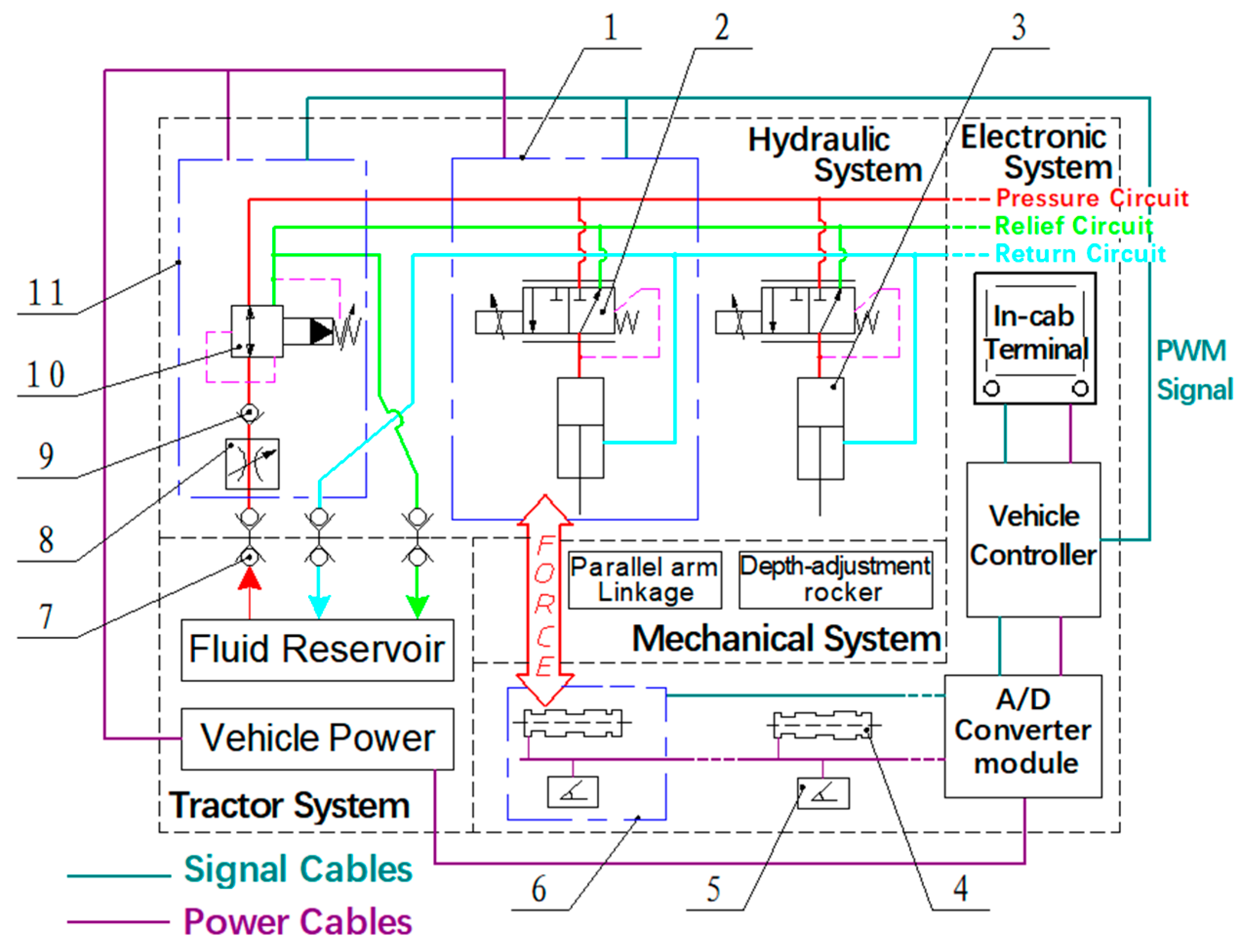
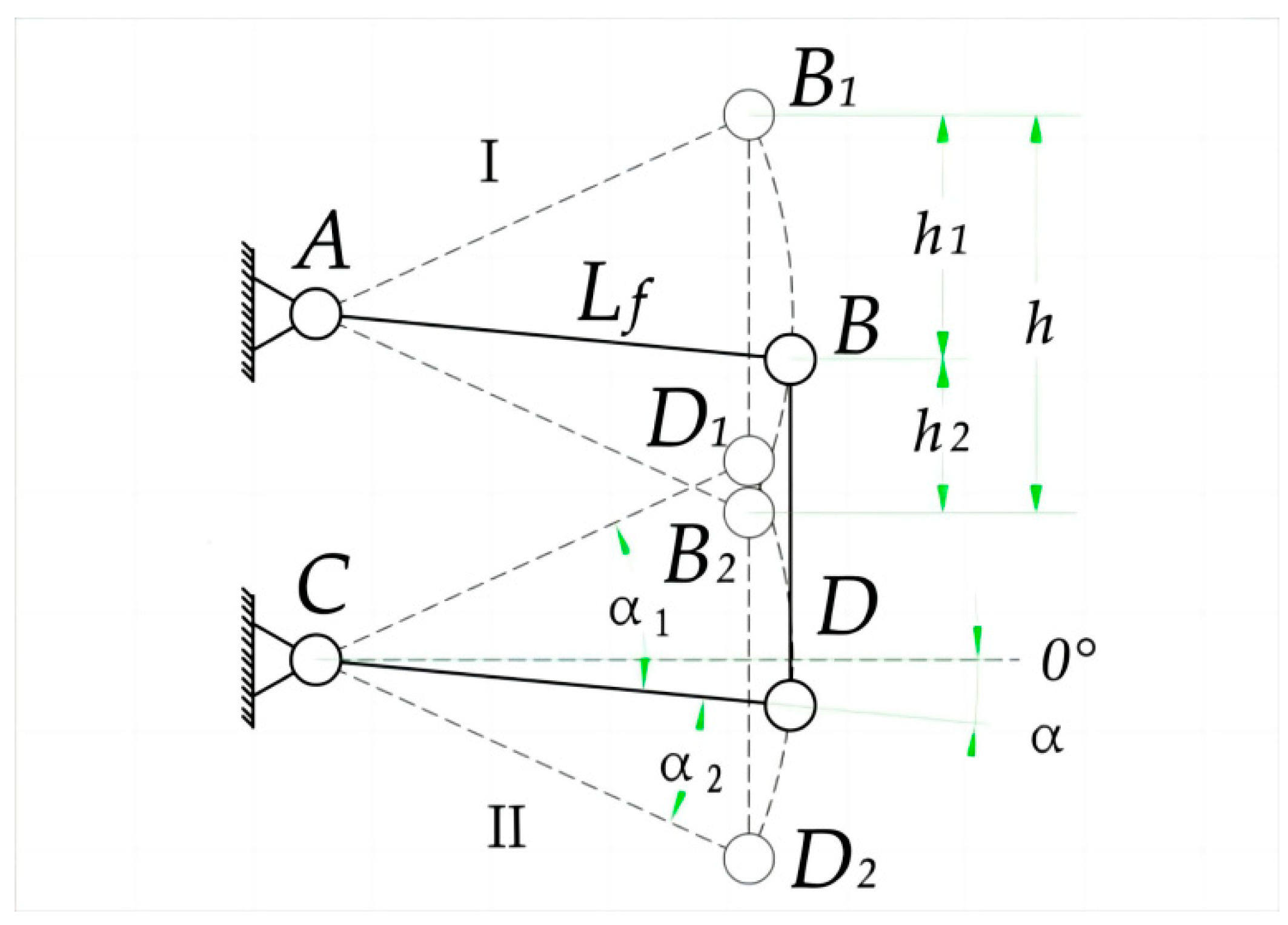

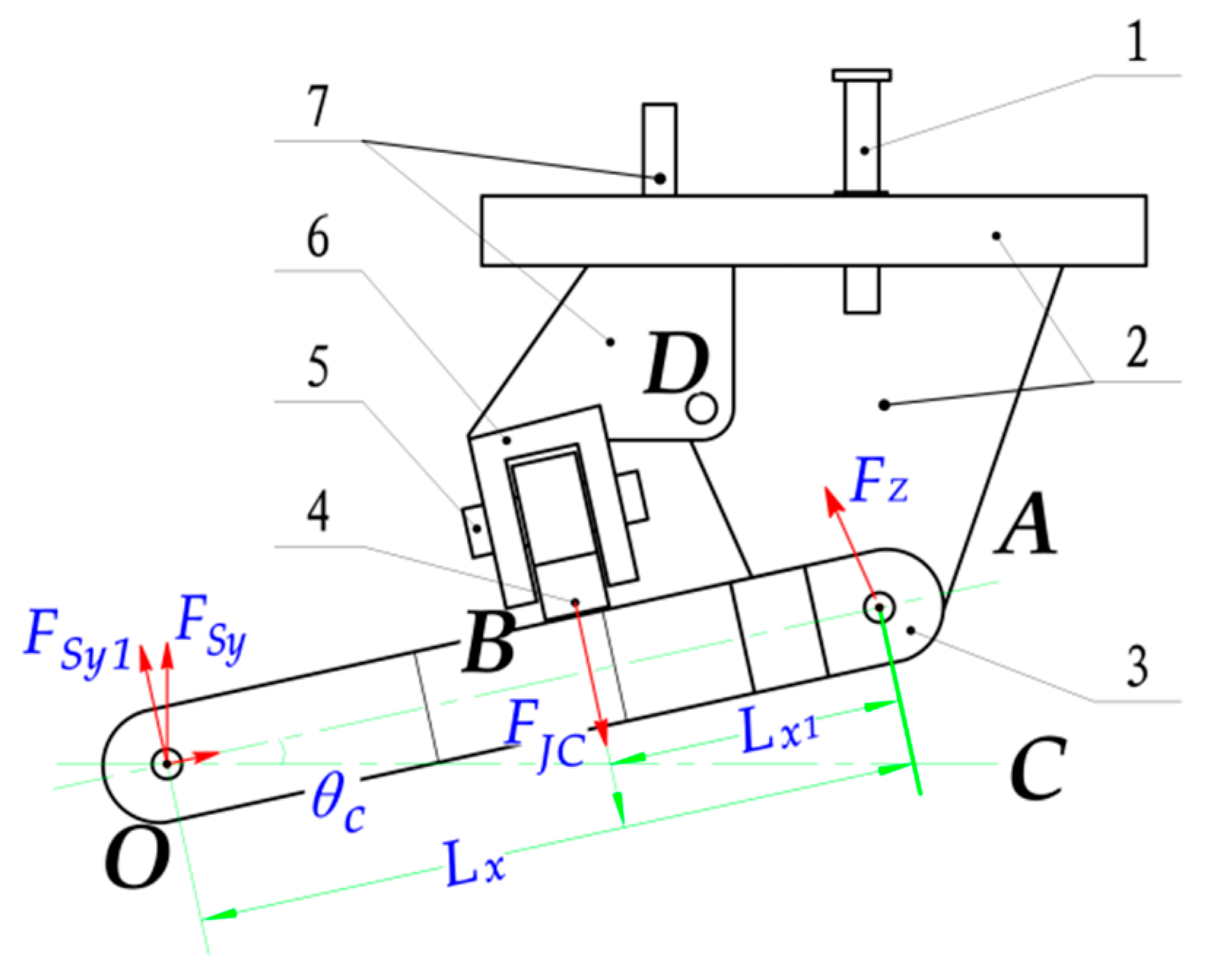
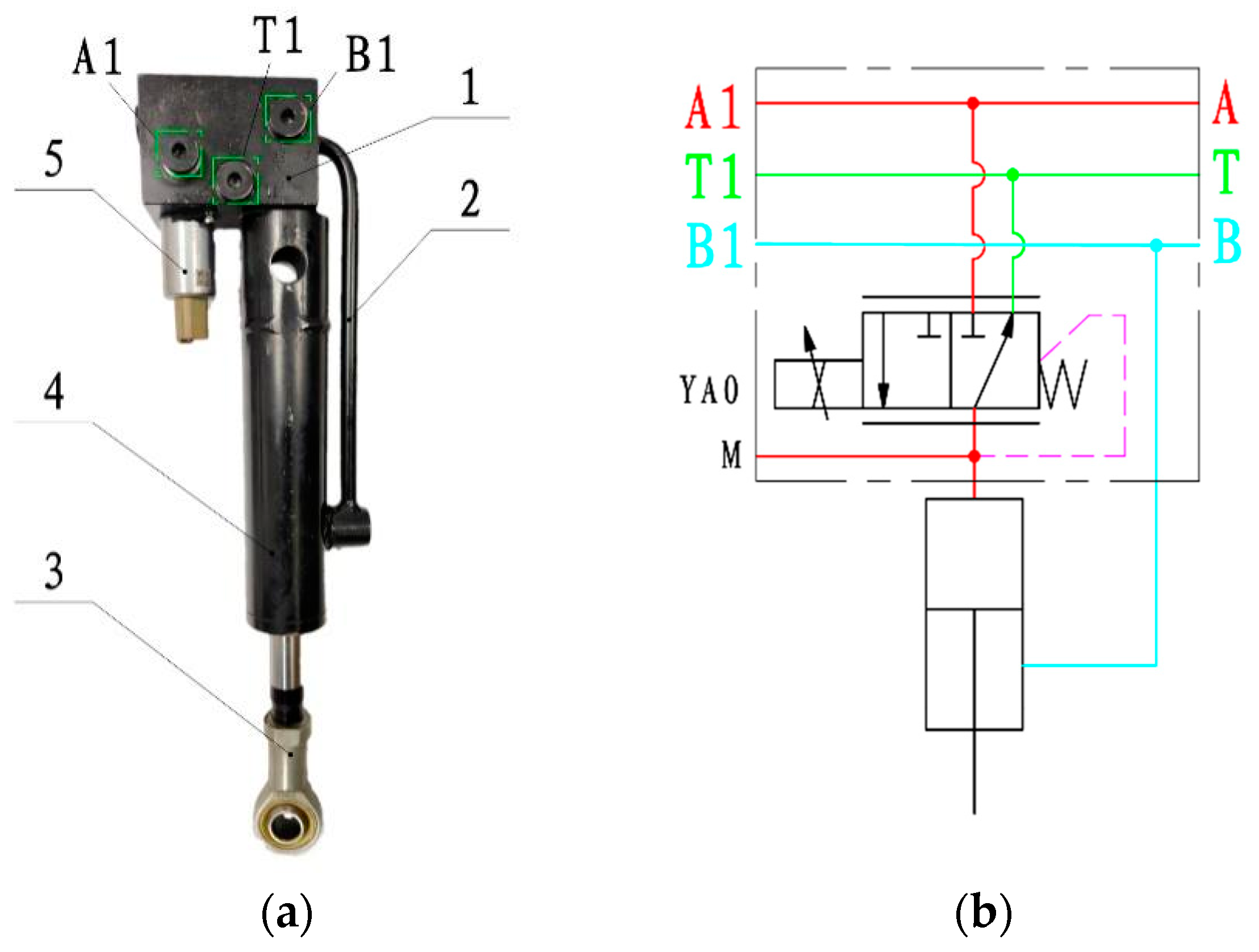


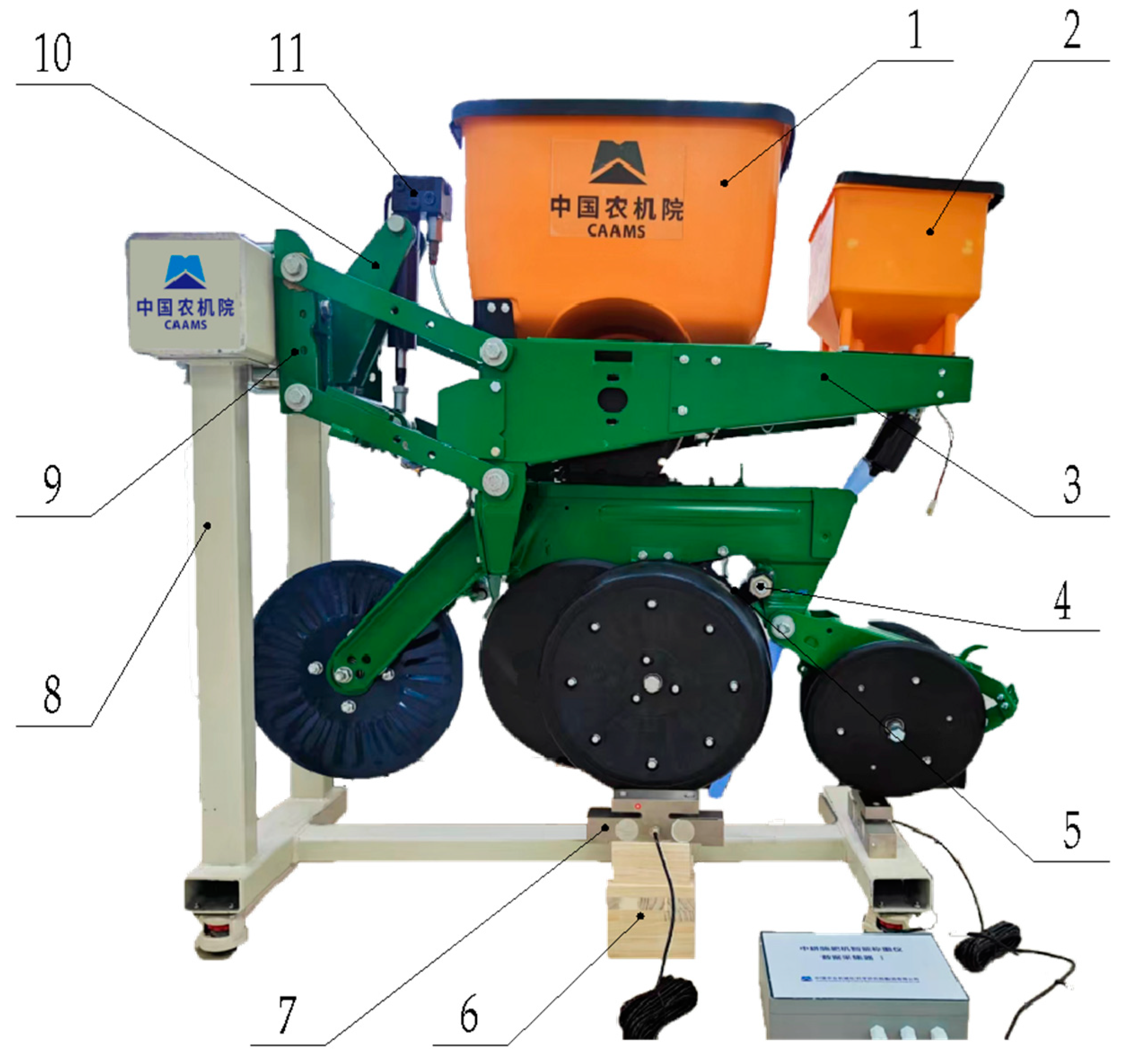
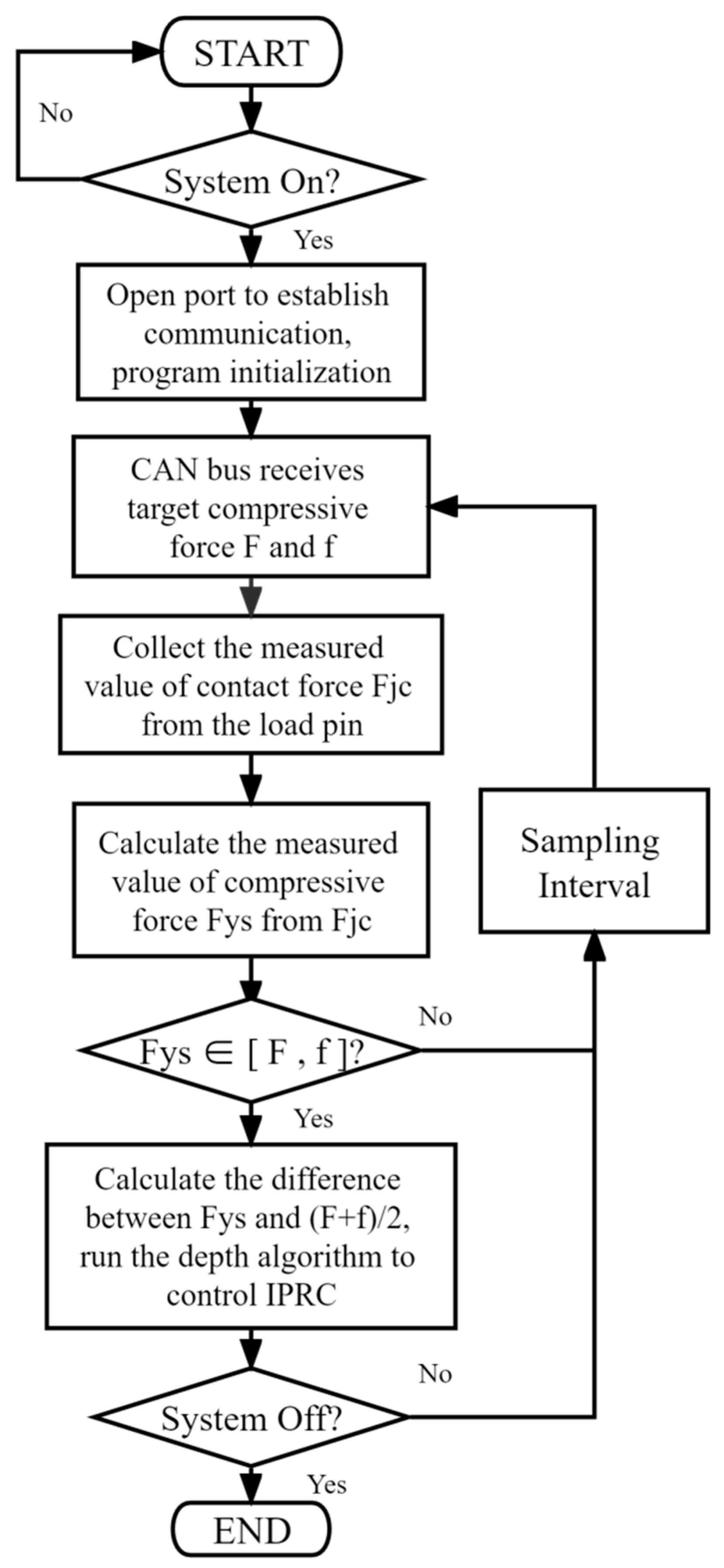

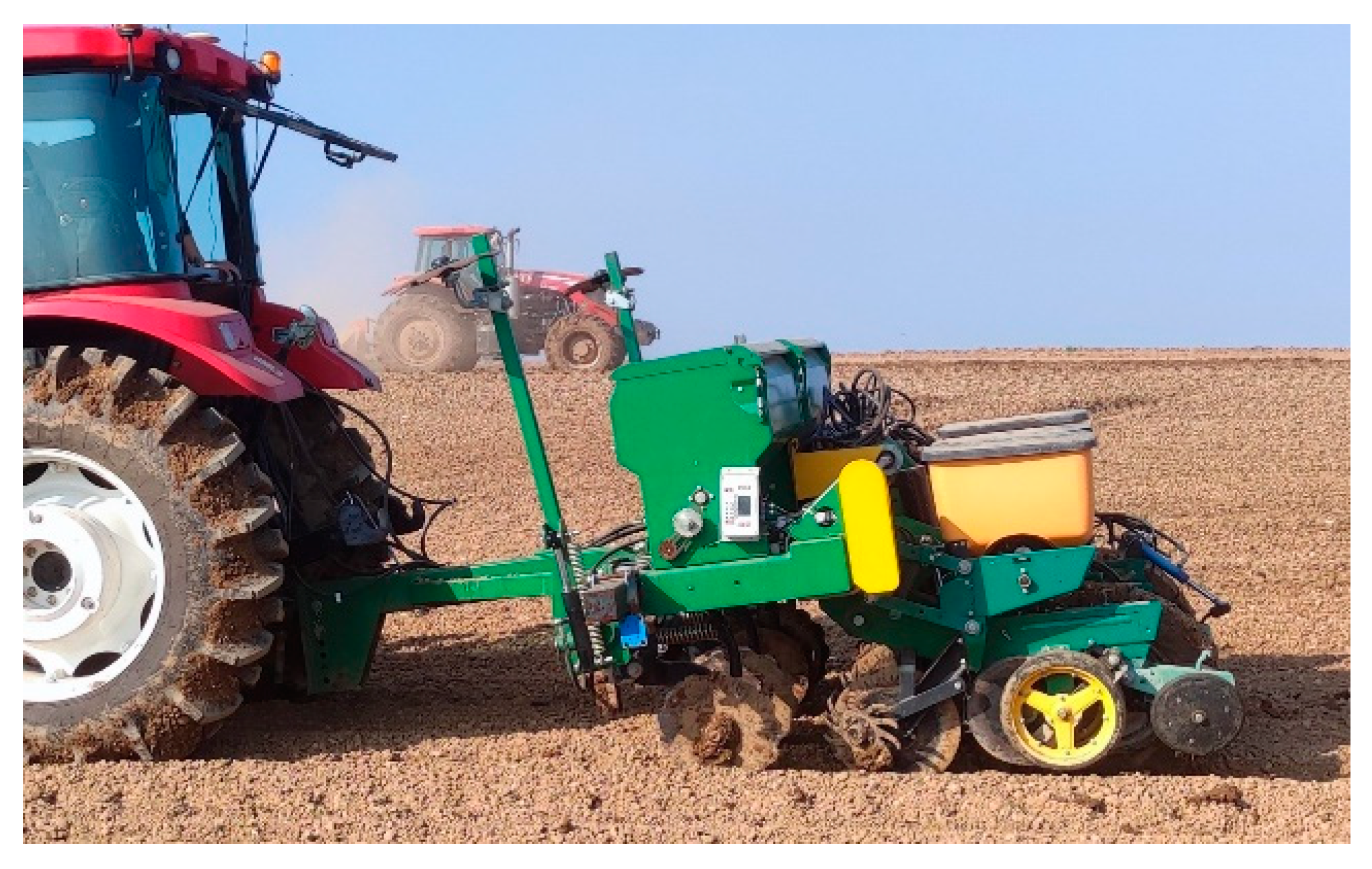
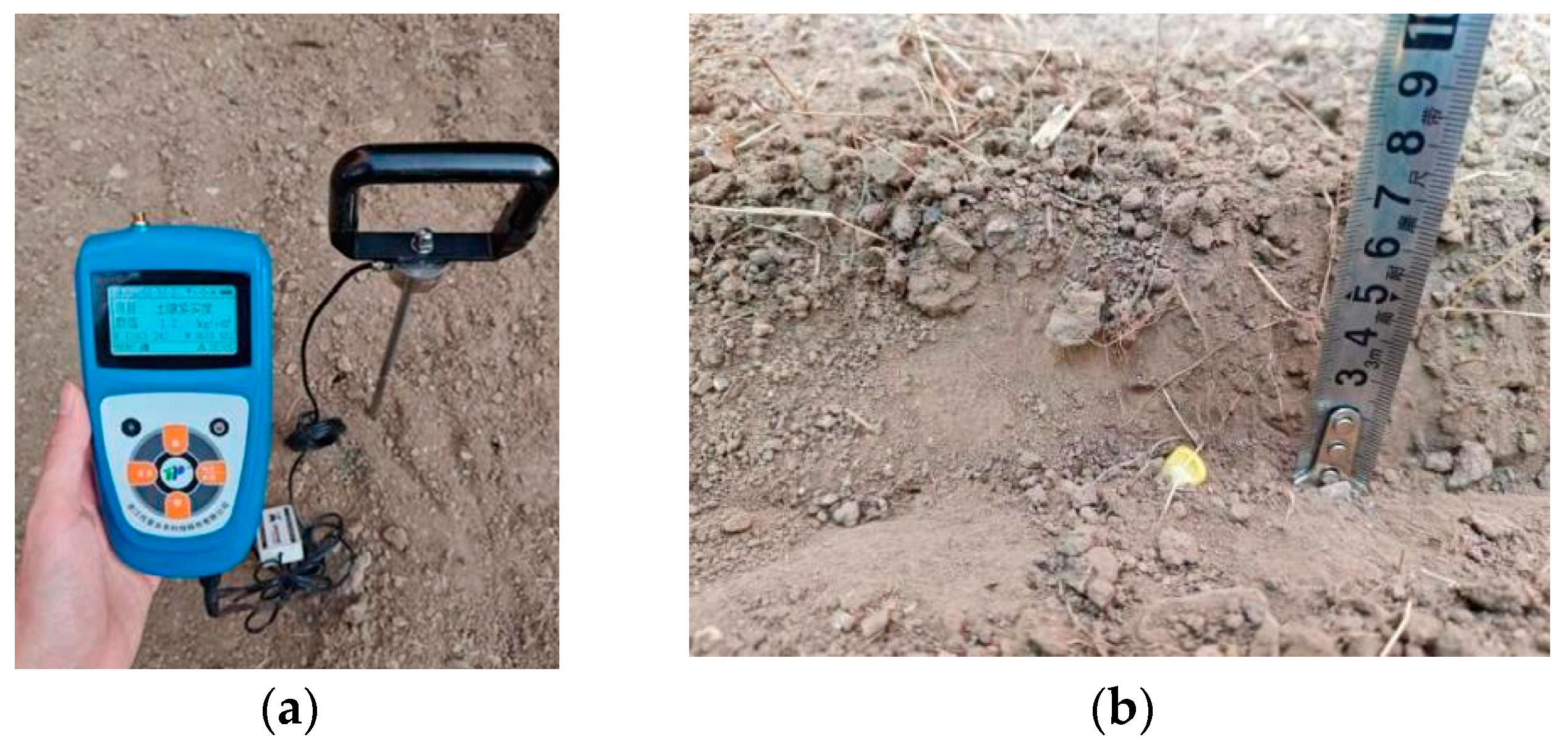
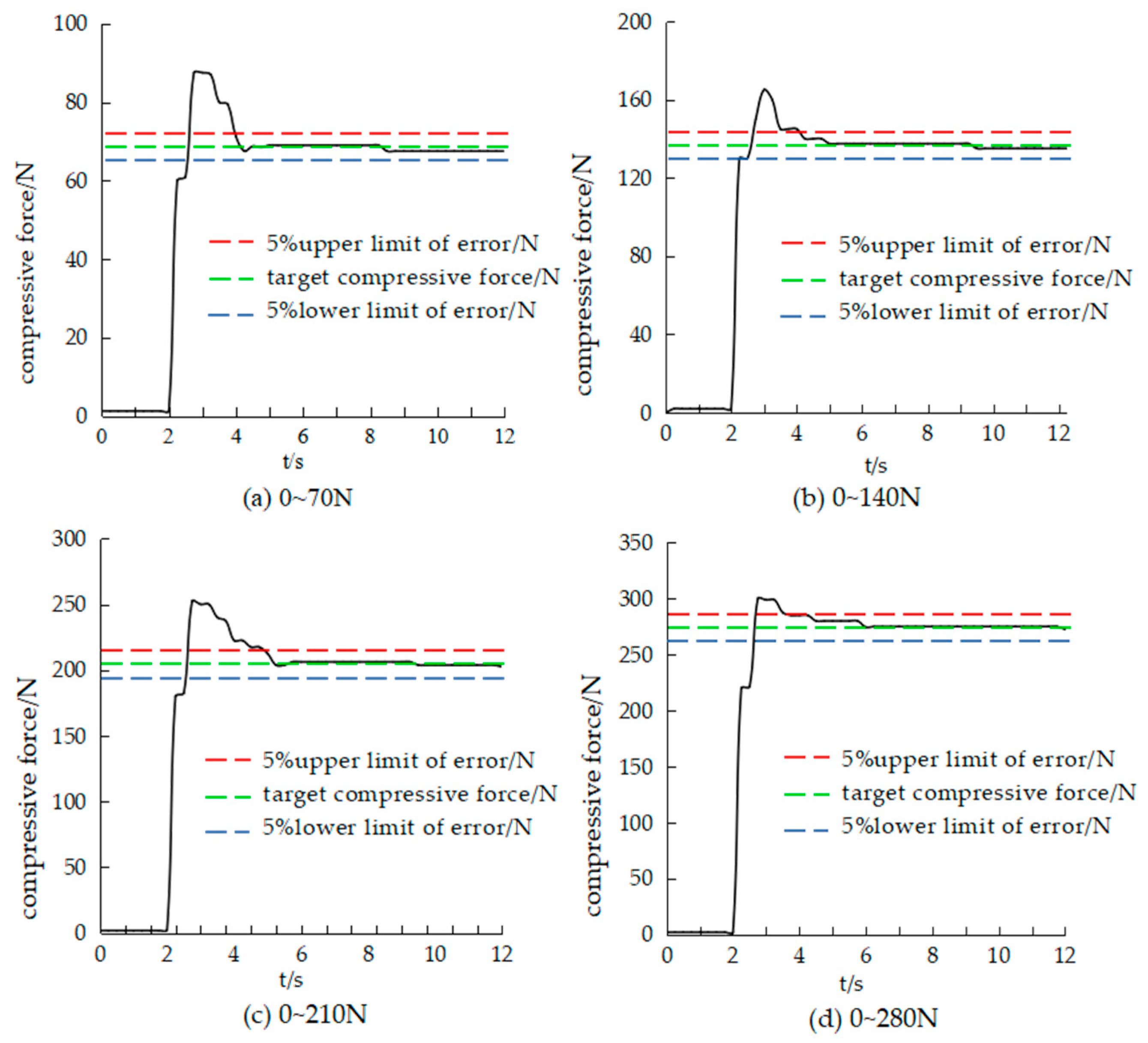
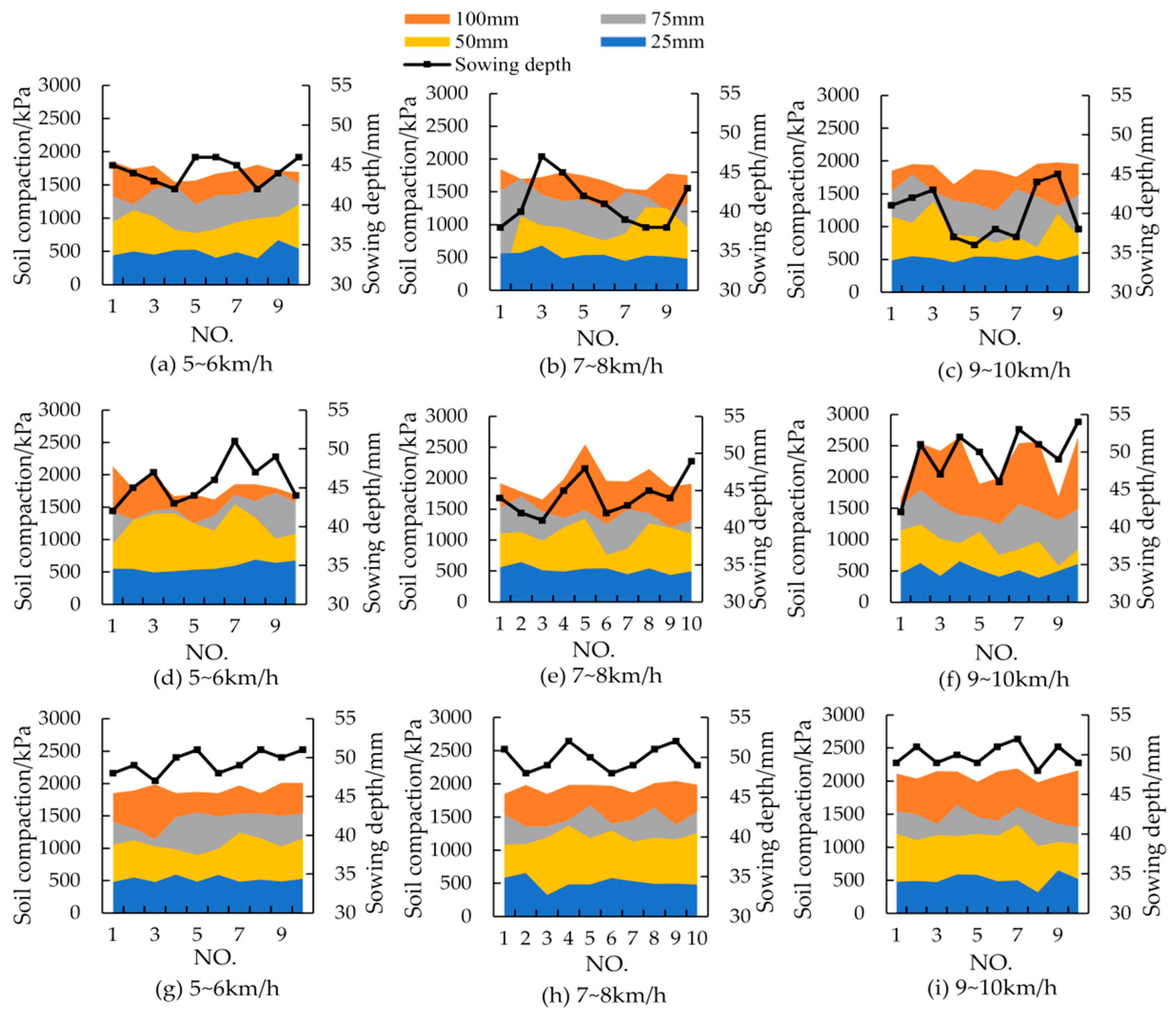
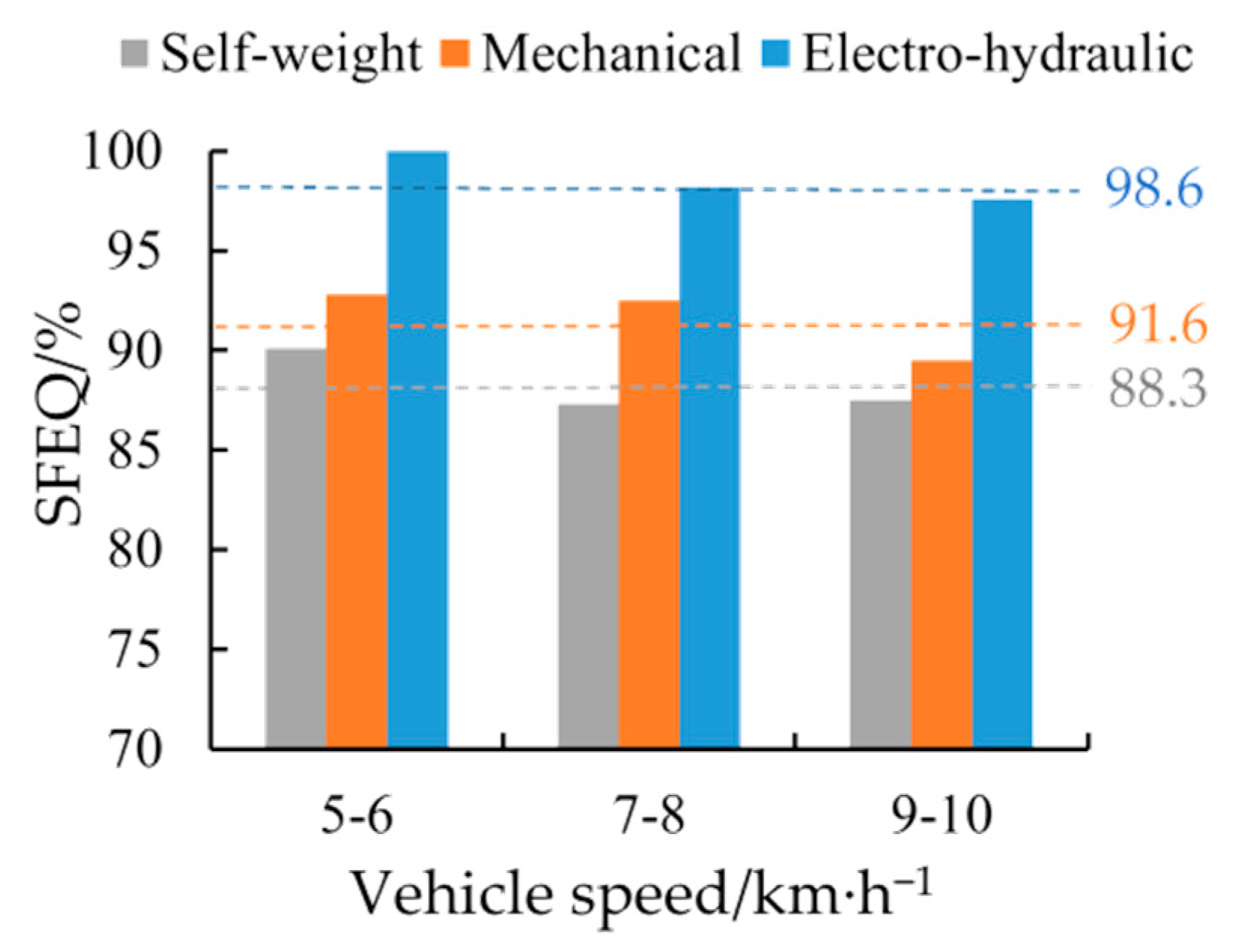
| Number | Target Compressive Force/N | Steady-State Value/N | Peak/N | Overshoot/% | Steady-State Error/N | Adjustment Time/s |
|---|---|---|---|---|---|---|
| 1 | 70 | 73.1 | 88.10 | 20.52 | 3.1 | 3.9 |
| 2 | 140 | 144.25 | 164.83 | 14.26 | 4.25 | 5.2 |
| 3 | 210 | 204.18 | 252.13 | 23.48 | 5.82 | 5.7 |
| 4 | 280 | 272.83 | 299.28 | 9.69 | 7.17 | 6.1 |
| avg | 16.99 | 8.63 | 5.23 |
| Plotting Parameters | Adjust Method | Vehicle Speed /(km∙h−1) | ||
|---|---|---|---|---|
| 5~6 | 7~8 | 9~10 | ||
| Average sowing depth/mm | Self-weight | 44.39 | 42.18 | 41.20 |
| Mechanical | 49.52 | 46.87 | 45.03 | |
| Electro-hydraulic | 49.63 | 49.40 | 49.27 | |
| Sowing depth qualification rate/% | Self-weight | 95.81 | 94.83 | 89.21 |
| Mechanical | 98.54 | 98.23 | 96.72 | |
| Electro-hydraulic | 100.00 | 100.00 | 98.62 | |
| Standard deviation of sowing depth/mm | Self-weight | 5.23 | 6.72 | 6.91 |
| Mechanical | 3.26 | 5.13 | 5.83 | |
| Electro-hydraulic | 3.80 | 2.97 | 3.17 | |
| Coefficient of variation of sowing depth/% | Self-weight | 11.78 | 15.93 | 16.77 |
| Mechanical | 6.58 | 10.95 | 12.95 | |
| Electro-hydraulic | 7.66 | 6.01 | 6.43 | |
Disclaimer/Publisher’s Note: The statements, opinions and data contained in all publications are solely those of the individual author(s) and contributor(s) and not of MDPI and/or the editor(s). MDPI and/or the editor(s) disclaim responsibility for any injury to people or property resulting from any ideas, methods, instructions or products referred to in the content. |
© 2023 by the authors. Licensee MDPI, Basel, Switzerland. This article is an open access article distributed under the terms and conditions of the Creative Commons Attribution (CC BY) license (https://creativecommons.org/licenses/by/4.0/).
Share and Cite
Zhou, L.; Ma, Y.; Zhou, H.; Niu, K.; Zhao, B.; Wei, L.; Bai, S.; Zheng, Y.; Zhang, W. Design and Test of Sowing Depth Measurement and Control System for No-Till Corn Seeder Based on Integrated Electro-Hydraulic Drive. Appl. Sci. 2023, 13, 5823. https://doi.org/10.3390/app13105823
Zhou L, Ma Y, Zhou H, Niu K, Zhao B, Wei L, Bai S, Zheng Y, Zhang W. Design and Test of Sowing Depth Measurement and Control System for No-Till Corn Seeder Based on Integrated Electro-Hydraulic Drive. Applied Sciences. 2023; 13(10):5823. https://doi.org/10.3390/app13105823
Chicago/Turabian StyleZhou, Liming, Yihua Ma, Haiyan Zhou, Kang Niu, Bo Zhao, Liguo Wei, Shenghe Bai, Yuankun Zheng, and Weipeng Zhang. 2023. "Design and Test of Sowing Depth Measurement and Control System for No-Till Corn Seeder Based on Integrated Electro-Hydraulic Drive" Applied Sciences 13, no. 10: 5823. https://doi.org/10.3390/app13105823
APA StyleZhou, L., Ma, Y., Zhou, H., Niu, K., Zhao, B., Wei, L., Bai, S., Zheng, Y., & Zhang, W. (2023). Design and Test of Sowing Depth Measurement and Control System for No-Till Corn Seeder Based on Integrated Electro-Hydraulic Drive. Applied Sciences, 13(10), 5823. https://doi.org/10.3390/app13105823





